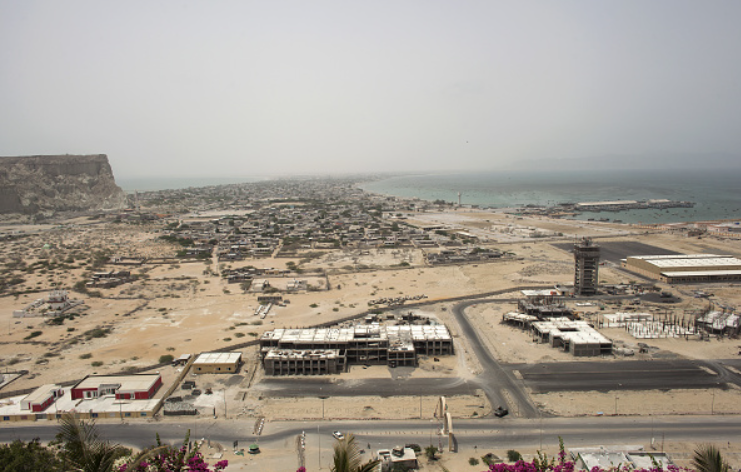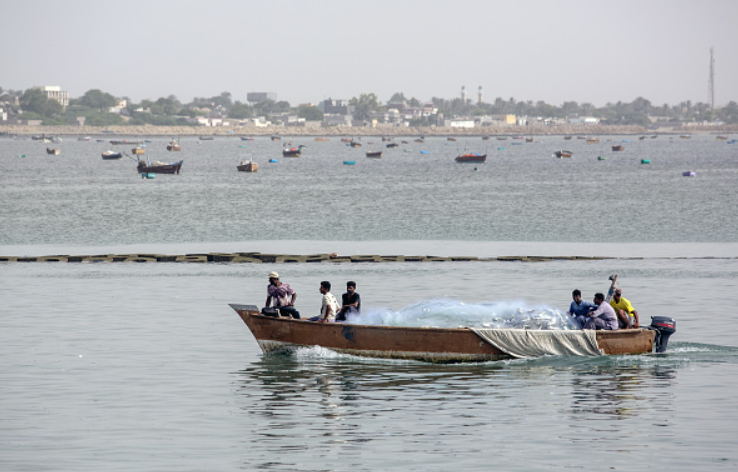Ayesha A. Malik

Situated on the shores of the Arabian Sea, Gwadar Port in Pakistan’s southwest Balochistan Province has long been touted as a potential hub for regional connectivity that would play an active role in the geopolitics of South Asia. A flagship project of the China-Pakistan Economic Corridor (CPEC) managed under 40 years lease project of China Overseas Ports Holding Company Pakistan (Pvt.) Ltd., the vision has been to turn Gwadar into a maritime trade hub connecting Pakistan, Afghanistan, Central Asia, and China.
The vision of regional integration positions Gwadar as foundation connecting economies of South, Central, and East Asia (primarily China). However, realizing this vision means not only building up Gwadar port as an economic hub, but through a network of roads and transit systems connecting the port to the region. This includes transit via Peshawar-Karachi Motorway —passing through Sindh, Punjab, and Khyber Pakhtunkhwa (KPK) as well as western route of CPEC, which has been designated as a “short-term” project and is under construction. However, the main transit is likely to go through the motorway crossing Punjab, Islamabad, and then Peshawar, creating a faster connection between Gwadar and China.
Strategic and political stability are critical to Gwadar project as well as Pakistan’s hope of bringing in the support of extra-regional stakeholders such as the United States or investment from the Middle East. Pakistan’s vision for Gwadar as a central economic node stems back to buying the port back from Oman in 1958, and the people of Gwadar, as stakeholders in developmental projects, have longed for the socio-economic growth since. However, as a multi-level administrative set-up (local, national, and Chinese) became active in developmental projects it discomposed livelihoods of local residents. As transit projects are at their core ventures to improve connectivity—an idea which rests on people-people connections—it is essential to safeguard the interests and livelihoods of concerned groups.
Gwadar and Visions for Regional Connectivity
The network of trade routes beginning from Gwadar is meant to augment high-profile connectivity across the region. These trade routes make Gwadar a prospective inter-junction as the Belt and Road Initiative (BRI) is estimated to link 3 billion people over three continents of Africa, Europe and Asia. Regionally, the transits proposed under CPEC from Gwadar to regional trade partners integrate with National Highway and Motorway networks. While these projects are often grouped together for CPEC connectivity, funding has come from multiple regional and extra-regional relationships, including roads built by the U.S. Agency for International Development, the Japan International Cooperation Agency, the Asian Development Bank, along with Pakistan-based private banks. In this arrangement, the interests of major stakeholders from the region and beyond converge on one core necessity for the projects—stability of the area and trade connectivity across the region.
For partners in landlocked countries of Central Asia, Gwadar is imaged as meeting point for a network of land and maritime trade routes.
For partners in landlocked countries of Central Asia, Gwadar is imaged as meeting point for a network of land and maritime trade routes. In March 2021, Pakistan signed bilateral agreements with Uzbekistan outlining procedures of trade and transit, which included access to Pakistan’s ports of Gwadar and Karachi. This followed previous conversations on building connectivity from Pakistan to Central Asia, including a 2018 proposition from the Uzbekistan government for a railway corridor from Termez through Afghanistan and into Peshawar in Pakistan, connecting with the Main Line One railway of CPEC. Pakistani companies also intend to invest in Uzbekistan free economic zones, which will allow them to access high quality Uzbek cotton, qualified labor, and a pass to free export regime to be used for trade with Central Asian states, which make up a population of 300 million people. As part of building connectivity with Central Asia, China and Pakistan have also proposed bringing Afghanistan into CPEC. Pakistan is the major trade door for Afghanistan through a transit gateway. This trade transit has two main crossing points; one, at the Chamman border in Balochistan and the second at Torkham in KPK.
Pakistan is in a position to capitalize on this opportunity and become regional connectivity hub and engage with various strategic partners due to Gwadar’s strategic position. Maximizing Gwadar port and its potential, however, requires an inter-structural scrutiny of the strategic, political, economic, and socio-cultural dimensions of the project, and asking how these factors will be impacted by regional and extra-regional connectivity goals.
Realities on the Ground
As the region undergoes a continued strategic transition, it is crucial to ask whether the Gwadar port project can feasibly carry out Pakistan’s objectives for regional connectivity. Gwadar, which is internally a fishing town, is facing issues of scarcity of basic needs including water, electricity, proper sanitation, which has pushed residents to migrate towards adjacent areas. Development projects of Gwadar present a model that alienates the local population. Protests by residents have demanded the sustained livelihood of local fishermen who lost significant fishing area along the coast due to construction of an expressway connecting Gwadar port to Makran Coastal Highway. Although resettlement compensation has reportedly been offered and Pakistan and China have made efforts for greater local involvement, the transnational nature of these plans and programs does not provide any guarantees. Internal migration and displacement has the potential to create grievances which could lead to conflict, restricting prospective regional integration. Incidents like the attack by the Balochistan Liberation Army on the Pearl Continental Hotel in 2019 and March 2021 Ganz, Gwadar District attack on a vehicle of Pakistan Navy, killing two navy members are a result of simmering grievances.

The challenges Gwadar and CPEC have faced in assessing local level issues will also need to be explored in transit routes to Afghanistan and elsewhere. Pakistan and Afghanistan recently extended the 10 year Afghanistan-Pakistan Transit Trade Agreement (APTTA) for three months, as both sides review and revise the original agreement until coming to mutual agreement. This protects Pakistan-Afghanistan trade via Gwadar because APTTA will not expire now as had been decided in 2010. The first transit cargo for Afghanistan through Gwadar was transported to Chaman in July 2020, and Afghan-India trade transit was also opened by government of Pakistan under APTTA in the same month. With Beijing interested in extending CPEC to Afghanistan, strategic and political turmoil remains the biggest constraint to transit trade from Gwadar.
Maintaining a trade network between Pakistan, Afghanistan, and other Central Asian countries requires stability as trade routes have previously been disrupted in times of political and strategic tensions between Pakistan and Afghanistan. For instance, the Torkham border crossing has recently been closed to “all types of immigration” due to coronavirus cases. The blocking of crossing points creates significant economic and humanitarian strife on both sides of the border. In 2016 an incident of Afghans setting Pakistani flag to fire while celebrating their Independence Day on other side of Chaman Border of Pakistan’s Balochistan resulted in closure of Chaman entry point for an average 10,000 to 15,000 traders who move across border every day. This was a season of harvesting grapes in Afghanistan’s southern Kandahar province. Due to the closures, the collected grapes could not be exported to Pakistan and had to be dried in to raisins. Farmers relying on the border crossing for trade could not receive what they expected while seeding their crop. The case highlights how a single incident can create blockages of trade, affecting transit activities and can potentially create consignment traffic jam at the port which can subsequently impact the agenda of regional connectivity.
The proposed route for Uzbekistan which became functional in May 2021 from Gwadar via Afghanistan into Uzbek lands has to pass through Pakistan’s Balochistan and Khyber Pakhtunkhwa (KPK) provinces. These are areas with active identity and ethnic politics where inhabitants have suffered internal displacements during War against Terrorism by Pakistan Armed Forces in the later province. Pashtuns of KPK with the merged tribal areas have a code of conduct which is an encompassing system known as Pashtunwali which is a self-regulatory, normative code and provide meta-systems of rule and progress, in specific Pashtun context. People of these areas with a history of cultural, social, political, administrative and economic autonomy are likely to be skeptical of state jurisdiction that penetrate deeper into their society and are likely to demand their share in any of the projects if it uses their lands.
The infrastructure built to materialize regional connections will be of no use if people-people connection across borders is not preserved in this region.
The ethno-cultural ties guided under Pashtunwali traversing around Torkham border impact the trade and people-to-people contact across the border. A case study of Shinwari Tribe may explain this. Shinwars live across Pakistan-Afghanistan border areas and have established families through centuries. For their convenient movement to and from Pakistan-Afghanistan, the government of Pakistan has provided them a National Identity number series (before it was Rahdari cards), to avoid any break in family congregations. Such examples explain the humanitarian constraints to any cases of border closures which suffer in cases of political tensions. There are security challenges of such porous border as there have been cases of illegal trade and drug trafficking. The infrastructure built to materialize regional connections will be of no use if people-people connection across borders is not preserved in this region.
The Road Ahead
The completion of this regional connectivity agenda through Gwadar has internal and external challenges ahead. Balochistan is politically, socially, and economically one of the most unstable provinces in Pakistan. Externally, the U.S. withdrawal from Afghanistan is posing serious threat to strategic stability and political steadiness of the region, as the Afghan Taliban are threatening an unabashed offensive which will strain regional relations, halt transits, close borders, and impact the citizens’ lives. Road networks under CPEC will take a route from Gwadar to China and move through KPK, however, Gwadar’s performance is likely to be impacted by strategic or political instability. The port can function successfully for deeper regional connectivity if geopolitical aims are addressed alongside socio-cultural realities in the policy making process. This may involve taking a bottom-up instead of top-down approach, which accounts for socio-cultural dynamics. In Central Asia, Pakistan is involved with developing deep rooted bilateral ties that can be improved by more flexible border arrangements with Afghanistan and Uzbekistan to establish people-people connection.
A free trade area can be another step towards deepening regional connectivity. Regional connectivity can also be enhanced through free trade areas, and working through multilateral forums like the Shanghai Cooperation Organization, SAARC, or the Organization of Islamic Cooperation for effective dispute resolution as regional disputes, such as the Pakistan-India rivalry, are a major constraint which can be addressed if connectivity initiatives can act as a point of economic integration rather than rivalry.
No comments:
Post a Comment